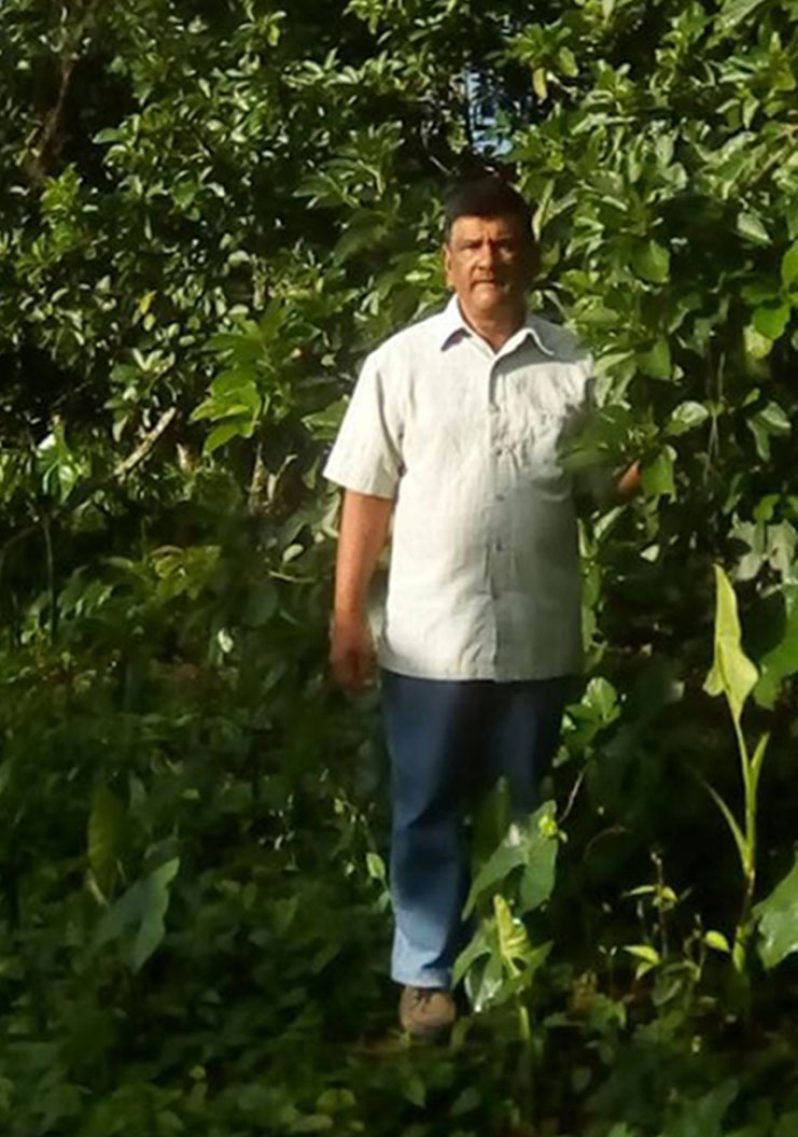By Gibron Rahim
AGRICULTURE feeds the nation. The idea may seem simple but it also underscores how profoundly essential farmers are to a country’s well-being. In an increasingly industrialised world, the disconnect between farm and table becomes ever wider, meaning that the role these humble men and women play in our lives often goes unnoticed. Yet, in Guyana, our dedicated farmers continue to produce and nourish our country. Among these farmers is Mr. Jagdeo Badray.
The soil on the Pomeroon River’s banks is arguably amongst the most fertile in Guyana. It is there that Badray’s home and farm are located. Badray, known in the community as ‘Daado’, inherited the farm from his father. Indeed, farming in the area tends to span generations with children working alongside their parents and then inheriting after their passing. Badray told the Pepperpot Magazine that he has been farming for a living since he was 18 years old. Now 55, his career in farming spans almost four decades.
Badray currently has 11 acres of farmland under cultivation. Among the crops cultivated are avocados, coffee, citrus fruits – tangerines, oranges and limes, coconuts and ground provisions such as plantains and cassava. He noted that avocados and coconuts are the farm’s biggest earners. The avocados, being a seasonal crop, are sold when they are in season. They are sold in Georgetown every year when their season comes around. On the other hand, the coconuts are harvested and sold every fortnight. The coconut harvest at that time can range from around five hundred coconuts to a thousand.
In addition to farming crops, Badray’s eldest son had at one time raised chickens for sale in the community. The young man no longer does so, though his father indicated that he might be considering a return to poultry farming for the Christmas season, a period when the demand for chicken is notably high.
Coffee cultivation was at one time widely practiced in the Pomeroon and the neighbouring areas of Moruca and Wakapoa. However, Badrey acknowledged that there was difficulty finding a market for the crop. And farming coffee itself is a very intensive process. Badray is among the few Pomeroon farmers who still cultivate coffee. He took some time to explain the processing that occurs before the beans are sold to manufacturers. The ripe coffee cherries are picked and pulped to get the coffee beans. The beans are then laid out to dry.
Once dried, they are hulled – a process whereby the outer skin is removed from the beans. They are sold to the manufacturer at this point and it is the manufacturer who handles parching and grinding the coffee beans for sale.
It was not the labour and cost intensive nature of coffee cultivation that killed it, however. The death knell for the widespread practice of coffee cultivation in the Pomeroon came from flooding. Flood waters over time killed many coffee trees and caused farmers to turn elsewhere. Farmers rely at present on crops whose cultivation is not as demanding as coffee while turning a decent profit at the same time. In the case of coconuts, it counts in their favour that they are quite hardy and more resistant to flood waters than many of their other crop counterparts.
The issue of flooding is one of major concern to Badray and his fellow farmers. The 2005 floods are marked in the memories of all Guyanese. The farmers in the Pomeroon were among those hardest hit. There is undoubtedly now a greater awareness among the farmers concerning drainage and irrigation, an awareness that every good farmer already has. This especially holds true for farming next to a river, as Pomeroon farmers do. Farm drainage and irrigation are inherently built around the ebb and flow of the waters flowing directly into the river from the Atlantic. Every farm along the river has at least one koker to transport water to and from the trenches and drains that traverse the land.
There are a few solutions that Badray and his family have formulated to handle assault from the Pomeroon’s high tides and heavy rains. “What we try to do is to make big dams to keep away all the water,” he said. Implementing that strategy has helped a lot in protecting crops that are particularly vulnerable to flooding. Flood waters, he explained, rots cassava and stunts plantain shrubs from bearing fruit.
The solution of bigger dams is not a foolproof one. Dams make no difference if water is not drawn off from the farmland, which is again dependent on the tides. This is a serious problem during periods of heavy rain when accumulated waters from the nearby lakes on the Essequibo Coast are released into the river to ease flooding. Water from rice fields on the coast is also sometimes drained into the river. Badray also indicated that the mouth of the Pomeroon River itself has become silted over the years. While this has been argued to prevent flooding at high tides, it also prevents greater drainage at low tides.
Despite the challenges he faces though, Badray remains dedicated to farming and continues to rely on it as his primary source of income. Farming is something he grew up with and he personally finds it financially worthwhile. More importantly, he and his family enjoy farming. In fact, his eldest and youngest sons have followed him into the career path. The resilience of Mr. Badray and his family is a testament to the resilience of Guyanese farmers. As he affirmed, “No matter what happens, you go right back and start fresh again.”



.jpg)











